ignition Alfa Romeo 4C 2016 Owner handbook (in English)
[x] Cancel search | Manufacturer: ALFA ROMEO, Model Year: 2016, Model line: 4C, Model: Alfa Romeo 4C 2016Pages: 182, PDF Size: 9.49 MB
Page 81 of 182
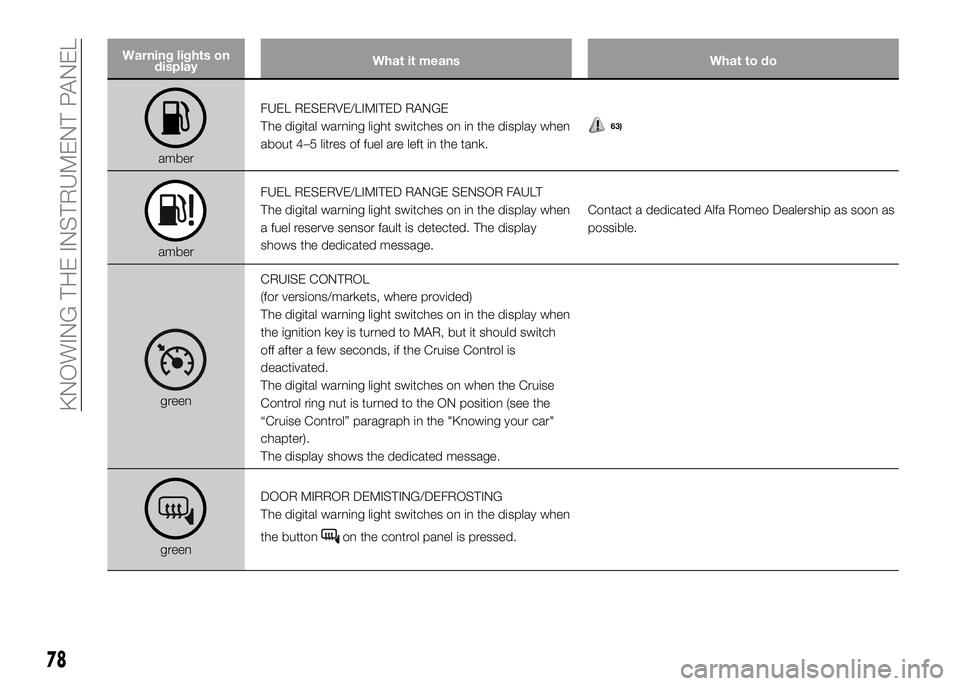
Warning lights on
displayWhat it means What to do
amberFUEL RESERVE/LIMITED RANGE
The digital warning light switches on in the display when
about 4–5 litres of fuel are left in the tank.
63)
amberFUEL RESERVE/LIMITED RANGE SENSOR FAULT
The digital warning light switches on in the display when
a fuel reserve sensor fault is detected. The display
shows the dedicated message.Contact a dedicated Alfa Romeo Dealership as soon as
possible.
greenCRUISE CONTROL
(for versions/markets, where provided)
The digital warning light switches on in the display when
the ignition key is turned to MAR, but it should switch
off after a few seconds, if the Cruise Control is
deactivated.
The digital warning light switches on when the Cruise
Control ring nut is turned to the ON position (see the
“Cruise Control” paragraph in the "Knowing your car"
chapter).
The display shows the dedicated message.
greenDOOR MIRROR DEMISTING/DEFROSTING
The digital warning light switches on in the display when
the buttonon the control panel is pressed.
78
KNOWING THE INSTRUMENT PANEL
Page 96 of 182
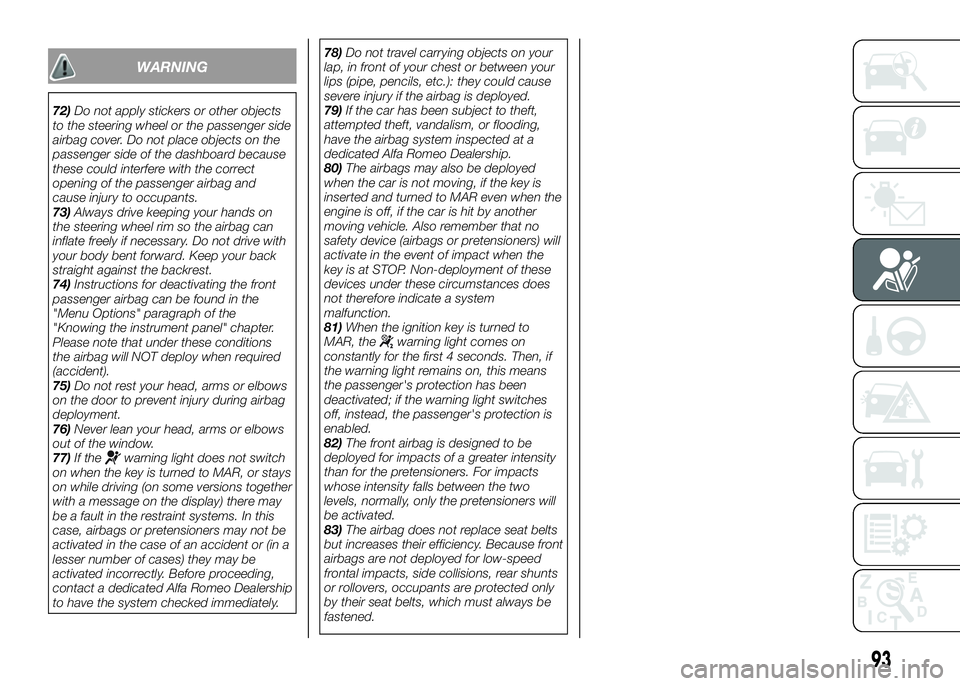
WARNING
72)Do not apply stickers or other objects
to the steering wheel or the passenger side
airbag cover. Do not place objects on the
passenger side of the dashboard because
these could interfere with the correct
opening of the passenger airbag and
cause injury to occupants.
73)Always drive keeping your hands on
the steering wheel rim so the airbag can
inflate freely if necessary. Do not drive with
your body bent forward. Keep your back
straight against the backrest.
74)Instructions for deactivating the front
passenger airbag can be found in the
"Menu Options" paragraph of the
"Knowing the instrument panel" chapter.
Please note that under these conditions
the airbag will NOT deploy when required
(accident).
75)Do not rest your head, arms or elbows
on the door to prevent injury during airbag
deployment.
76)Never lean your head, arms or elbows
out of the window.
77)If the
warning light does not switch
on when the key is turned to MAR, or stays
on while driving (on some versions together
with a message on the display) there may
be a fault in the restraint systems. In this
case, airbags or pretensioners may not be
activated in the case of an accident or (in a
lesser number of cases) they may be
activated incorrectly. Before proceeding,
contact a dedicated Alfa Romeo Dealership
to have the system checked immediately.78)Do not travel carrying objects on your
lap, in front of your chest or between your
lips (pipe, pencils, etc.): they could cause
severe injury if the airbag is deployed.
79)If the car has been subject to theft,
attempted theft, vandalism, or flooding,
have the airbag system inspected at a
dedicated Alfa Romeo Dealership.
80)The airbags may also be deployed
when the car is not moving, if the key is
inserted and turned to MAR even when the
engine is off, if the car is hit by another
moving vehicle. Also remember that no
safety device (airbags or pretensioners) will
activate in the event of impact when the
key is at STOP. Non-deployment of these
devices under these circumstances does
not therefore indicate a system
malfunction.
81)When the ignition key is turned to
MAR, the
warning light comes on
constantly for the first 4 seconds. Then, if
the warning light remains on, this means
the passenger's protection has been
deactivated; if the warning light switches
off, instead, the passenger's protection is
enabled.
82)The front airbag is designed to be
deployed for impacts of a greater intensity
than for the pretensioners. For impacts
whose intensity falls between the two
levels, normally, only the pretensioners will
be activated.
83)The airbag does not replace seat belts
but increases their efficiency. Because front
airbags are not deployed for low-speed
frontal impacts, side collisions, rear shunts
or rollovers, occupants are protected only
by their seat belts, which must always be
fastened.
93
Page 98 of 182
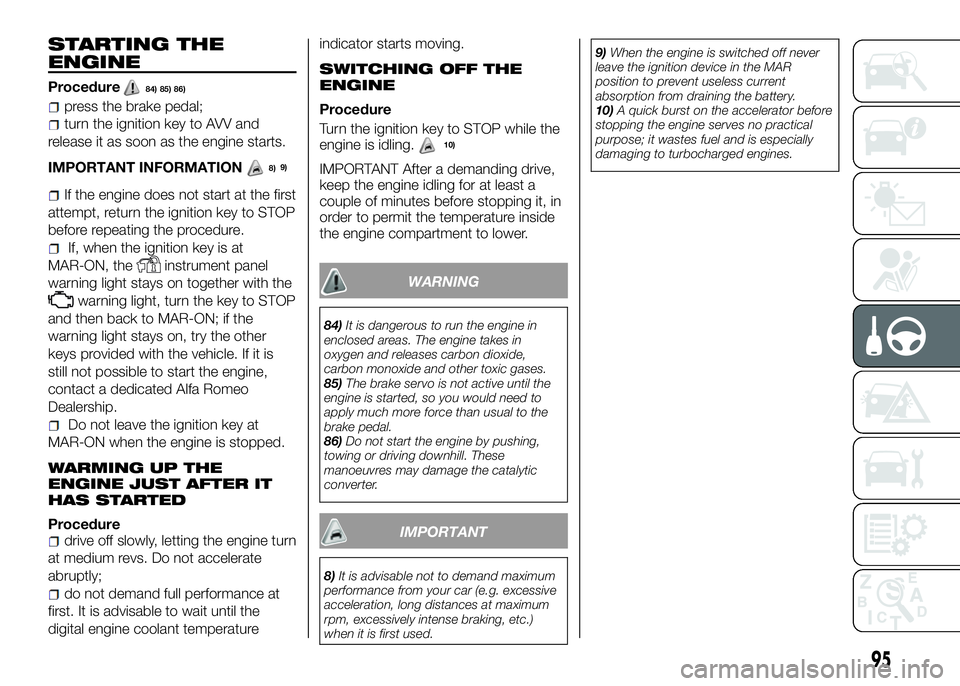
STARTING THE
ENGINE
Procedure84) 85) 86)
press the brake pedal;
turn the ignition key to AVV and
release it as soon as the engine starts.
IMPORTANT INFORMATION
9)
If the engine does not start at the first
attempt, return the ignition key to STOP
before repeating the procedure.
If, when the ignition key is at
MAR-ON, the
instrument panel
warning light stays on together with the
warning light, turn the key to STOP
and then back to MAR-ON; if the
warning light stays on, try the other
keys provided with the vehicle. If it is
still not possible to start the engine,
contact a dedicated Alfa Romeo
Dealership.
Do not leave the ignition key at
MAR-ON when the engine is stopped.
WARMING UP THE
ENGINE JUST AFTER IT
HAS STARTED
Proceduredrive off slowly, letting the engine turn
at medium revs. Do not accelerate
abruptly;
do not demand full performance at
first. It is advisable to wait until the
digital engine coolant temperatureindicator starts moving.
SWITCHING OFF THE
ENGINE
Procedure
Turn the ignition key to STOP while the
engine is idling.
IMPORTANT After a demanding drive,
keep the engine idling for at least a
couple of minutes before stopping it, in
order to permit the temperature inside
the engine compartment to lower.
WARNING
84)It is dangerous to run the engine in
enclosed areas. The engine takes in
oxygen and releases carbon dioxide,
carbon monoxide and other toxic gases.
85)The brake servo is not active until the
engine is started, so you would need to
apply much more force than usual to the
brake pedal.
86)Do not start the engine by pushing,
towing or driving downhill. These
manoeuvres may damage the catalytic
converter.
IMPORTANT
8)It is advisable not to demand maximum
performance from your car (e.g. excessive
acceleration, long distances at maximum
rpm, excessively intense braking, etc.)
when it is first used.9)When the engine is switched off never
leave the ignition device in the MAR
position to prevent useless current
absorption from draining the battery.
10)A quick burst on the accelerator before
stopping the engine serves no practical
purpose; it wastes fuel and is especially
damaging to turbocharged engines.
95
8)10)
Page 99 of 182
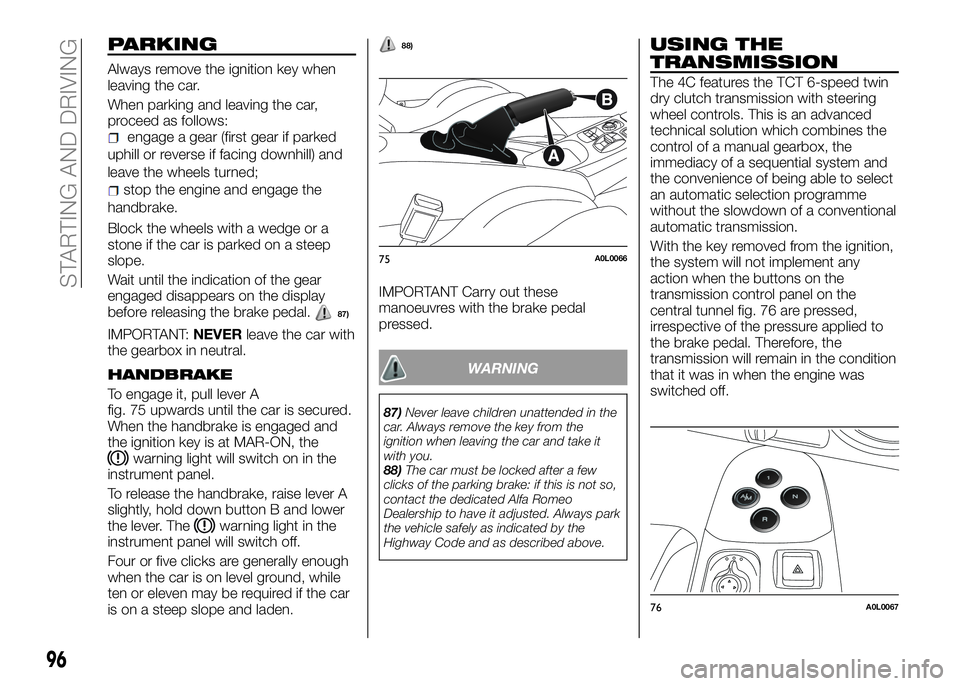
PARKING
Always remove the ignition key when
leaving the car.
When parking and leaving the car,
proceed as follows:
engage a gear (first gear if parked
uphill or reverse if facing downhill) and
leave the wheels turned;
stop the engine and engage the
handbrake.
Block the wheels with a wedge or a
stone if the car is parked on a steep
slope.
Wait until the indication of the gear
engaged disappears on the display
before releasing the brake pedal.
87)
IMPORTANT:NEVERleave the car with
the gearbox in neutral.
HANDBRAKE
To engage it, pull lever A
fig. 75 upwards until the car is secured.
When the handbrake is engaged and
the ignition key is at MAR-ON, the
warning light will switch on in the
instrument panel.
To release the handbrake, raise lever A
slightly, hold down button B and lower
the lever. The
warning light in the
instrument panel will switch off.
Four or five clicks are generally enough
when the car is on level ground, while
ten or eleven may be required if the car
is on a steep slope and laden.
88)
IMPORTANT Carry out these
manoeuvres with the brake pedal
pressed.
WARNING
87)Never leave children unattended in the
car. Always remove the key from the
ignition when leaving the car and take it
with you.
88)The car must be locked after a few
clicks of the parking brake: if this is not so,
contact the dedicated Alfa Romeo
Dealership to have it adjusted. Always park
the vehicle safely as indicated by the
Highway Code and as described above.
USING THE
TRANSMISSION
The 4C features the TCT 6-speed twin
dry clutch transmission with steering
wheel controls. This is an advanced
technical solution which combines the
control of a manual gearbox, the
immediacy of a sequential system and
the convenience of being able to select
an automatic selection programme
without the slowdown of a conventional
automatic transmission.
With the key removed from the ignition,
the system will not implement any
action when the buttons on the
transmission control panel on the
central tunnel fig. 76 are pressed,
irrespective of the pressure applied to
the brake pedal. Therefore, the
transmission will remain in the condition
that it was in when the engine was
switched off.
75A0L0066
76A0L0067
96
STARTING AND DRIVING
Page 100 of 182
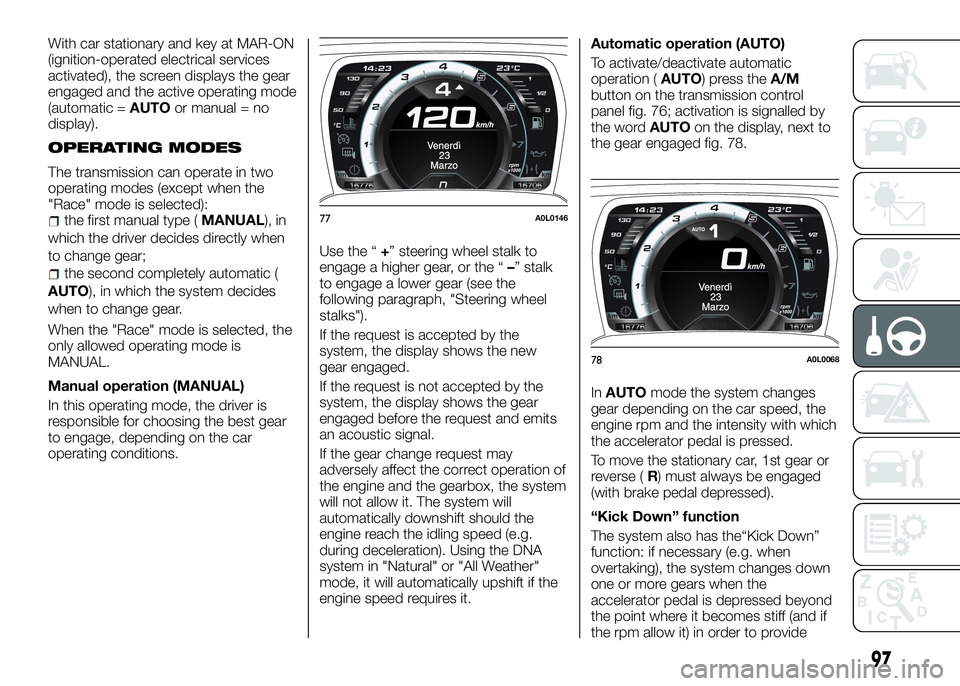
With car stationary and key at MAR-ON
(ignition-operated electrical services
activated), the screen displays the gear
engaged and the active operating mode
(automatic =AUTOor manual = no
display).
OPERATING MODES
The transmission can operate in two
operating modes (except when the
"Race" mode is selected):
the first manual type (MANUAL), in
which the driver decides directly when
to change gear;
the second completely automatic (
AUTO), in which the system decides
when to change gear.
When the "Race" mode is selected, the
only allowed operating mode is
MANUAL.
Manual operation (MANUAL)
In this operating mode, the driver is
responsible for choosing the best gear
to engage, depending on the car
operating conditions.Use the “+” steering wheel stalk to
engage a higher gear, or the “–” stalk
to engage a lower gear (see the
following paragraph, "Steering wheel
stalks").
If the request is accepted by the
system, the display shows the new
gear engaged.
If the request is not accepted by the
system, the display shows the gear
engaged before the request and emits
an acoustic signal.
If the gear change request may
adversely affect the correct operation of
the engine and the gearbox, the system
will not allow it. The system will
automatically downshift should the
engine reach the idling speed (e.g.
during deceleration). Using the DNA
system in "Natural" or "All Weather"
mode, it will automatically upshift if the
engine speed requires it.Automatic operation (AUTO)
To activate/deactivate automatic
operation (AUTO) press theA/M
button on the transmission control
panel fig. 76; activation is signalled by
the wordAUTOon the display, next to
the gear engaged fig. 78.
InAUTOmode the system changes
gear depending on the car speed, the
engine rpm and the intensity with which
the accelerator pedal is pressed.
To move the stationary car, 1st gear or
reverse (R) must always be engaged
(with brake pedal depressed).
“Kick Down” function
The system also has the“Kick Down”
function: if necessary (e.g. when
overtaking), the system changes down
one or more gears when the
accelerator pedal is depressed beyond
the point where it becomes stiff (and if
the rpm allow it) in order to provide
77A0L0146
78A0L0068
97
Page 102 of 182
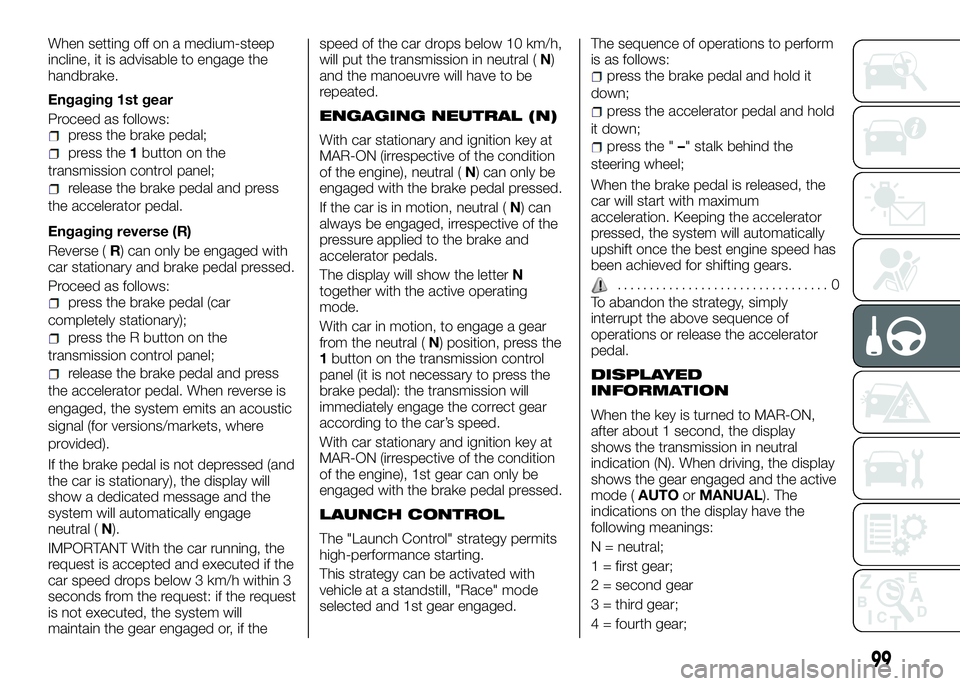
When setting off on a medium-steep
incline, it is advisable to engage the
handbrake.
Engaging 1st gear
Proceed as follows:
press the brake pedal;
press the1button on the
transmission control panel;
release the brake pedal and press
the accelerator pedal.
Engaging reverse (R)
Reverse (R) can only be engaged with
car stationary and brake pedal pressed.
Proceed as follows:
press the brake pedal (car
completely stationary);
press the R button on the
transmission control panel;
release the brake pedal and press
the accelerator pedal. When reverse is
engaged, the system emits an acoustic
signal (for versions/markets, where
provided).
If the brake pedal is not depressed (and
the car is stationary), the display will
show a dedicated message and the
system will automatically engage
neutral (N).
IMPORTANT With the car running, the
request is accepted and executed if the
car speed drops below 3 km/h within 3
seconds from the request: if the request
is not executed, the system will
maintain the gear engaged or, if thespeed of the car drops below 10 km/h,
will put the transmission in neutral (N)
and the manoeuvre will have to be
repeated.
ENGAGING NEUTRAL (N)
With car stationary and ignition key at
MAR-ON (irrespective of the condition
of the engine), neutral (N) can only be
engaged with the brake pedal pressed.
If the car is in motion, neutral (N) can
always be engaged, irrespective of the
pressure applied to the brake and
accelerator pedals.
The display will show the letterN
together with the active operating
mode.
With car in motion, to engage a gear
from the neutral (N) position, press the
1button on the transmission control
panel (it is not necessary to press the
brake pedal): the transmission will
immediately engage the correct gear
according to the car’s speed.
With car stationary and ignition key at
MAR-ON (irrespective of the condition
of the engine), 1st gear can only be
engaged with the brake pedal pressed.
LAUNCH CONTROL
The "Launch Control" strategy permits
high-performance starting.
This strategy can be activated with
vehicle at a standstill, "Race" mode
selected and 1st gear engaged.The sequence of operations to perform
is as follows:
press the brake pedal and hold it
down;
press the accelerator pedal and hold
it down;
press the "–" stalk behind the
steering wheel;
When the brake pedal is released, the
car will start with maximum
acceleration. Keeping the accelerator
pressed, the system will automatically
upshift once the best engine speed has
been achieved for shifting gears.
................................. 0
To abandon the strategy, simply
interrupt the above sequence of
operations or release the accelerator
pedal.
DISPLAYED
INFORMATION
When the key is turned to MAR-ON,
after about 1 second, the display
shows the transmission in neutral
indication (N). When driving, the display
shows the gear engaged and the active
mode (AUTOorMANUAL). The
indications on the display have the
following meanings:
N = neutral;
1 = first gear;
2 = second gear
3 = third gear;
4 = fourth gear;
99
Page 103 of 182
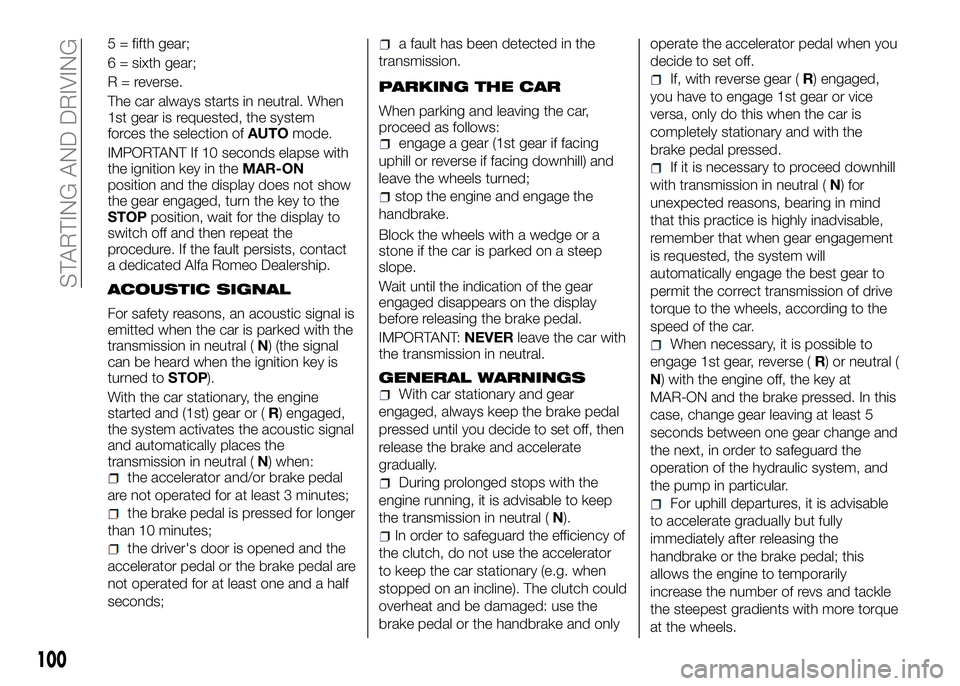
5 = fifth gear;
6 = sixth gear;
R = reverse.
The car always starts in neutral. When
1st gear is requested, the system
forces the selection ofAUTOmode.
IMPORTANT If 10 seconds elapse with
the ignition key in theMAR-ON
position and the display does not show
the gear engaged, turn the key to the
STOPposition, wait for the display to
switch off and then repeat the
procedure. If the fault persists, contact
a dedicated Alfa Romeo Dealership.
ACOUSTIC SIGNAL
For safety reasons, an acoustic signal is
emitted when the car is parked with the
transmission in neutral (N) (the signal
can be heard when the ignition key is
turned toSTOP).
With the car stationary, the engine
started and (1st) gear or (R) engaged,
the system activates the acoustic signal
and automatically places the
transmission in neutral (N) when:
the accelerator and/or brake pedal
are not operated for at least 3 minutes;
the brake pedal is pressed for longer
than 10 minutes;
the driver's door is opened and the
accelerator pedal or the brake pedal are
not operated for at least one and a half
seconds;
a fault has been detected in the
transmission.
PARKING THE CAR
When parking and leaving the car,
proceed as follows:
engage a gear (1st gear if facing
uphill or reverse if facing downhill) and
leave the wheels turned;
stop the engine and engage the
handbrake.
Block the wheels with a wedge or a
stone if the car is parked on a steep
slope.
Wait until the indication of the gear
engaged disappears on the display
before releasing the brake pedal.
IMPORTANT:NEVERleave the car with
the transmission in neutral.
GENERAL WARNINGSWith car stationary and gear
engaged, always keep the brake pedal
pressed until you decide to set off, then
release the brake and accelerate
gradually.
During prolonged stops with the
engine running, it is advisable to keep
the transmission in neutral (N).
In order to safeguard the efficiency of
the clutch, do not use the accelerator
to keep the car stationary (e.g. when
stopped on an incline). The clutch could
overheat and be damaged: use the
brake pedal or the handbrake and onlyoperate the accelerator pedal when you
decide to set off.
If, with reverse gear (R) engaged,
you have to engage 1st gear or vice
versa, only do this when the car is
completely stationary and with the
brake pedal pressed.
If it is necessary to proceed downhill
with transmission in neutral (N) for
unexpected reasons, bearing in mind
that this practice is highly inadvisable,
remember that when gear engagement
is requested, the system will
automatically engage the best gear to
permit the correct transmission of drive
torque to the wheels, according to the
speed of the car.
When necessary, it is possible to
engage 1st gear, reverse (R) or neutral (
N) with the engine off, the key at
MAR-ON and the brake pressed. In this
case, change gear leaving at least 5
seconds between one gear change and
the next, in order to safeguard the
operation of the hydraulic system, and
the pump in particular.
For uphill departures, it is advisable
to accelerate gradually but fully
immediately after releasing the
handbrake or the brake pedal; this
allows the engine to temporarily
increase the number of revs and tackle
the steepest gradients with more torque
at the wheels.
100
STARTING AND DRIVING
Page 106 of 182

SNOW CHAINS
Reduced size snow chains with a
maximum projection of 7 mm beyond
the tyre profile can be fitted only on
235/40 R18 rear tyres.
The use of snow chains should be in
compliance with local regulations. Snow
chains can be fitted on the tyres of the
rear wheels (drive wheels) only. 19" rear
tyres cannot be fitted with chains.
Check the tension of the snow chains
after the first few metres have been
driven.
11)
IMPORTANT Snow chains cannot be
fitted to the space-saver wheel (for
versions/markets, where provided).
IMPORTANT
11)Keep your speed down when snow
chains are fitted; do not exceed 50 km/h
(or the equivalent in miles). Avoid potholes,
do not drive over steps or sidewalks and do
not drive long distances over roads without
snow, to avoid damaging both your vehicle
and the road surface.
CAR INACTIVITY
If the vehicle is to be left inactive for
longer than a month, observe the
following precautions:
park the car in covered, dry and if
possible well-ventilated premises and
slightly open the windows;
check that the handbrake is not
engaged;
disconnect the negative battery
terminal and check the battery charge.
Repeat this check once every three
months during storage. For optimum
preservation of the battery charge, it is
advisable to use the charge-holder (for
versions/markets, where provided, or
alternatively, available from
Lineaccessori). For more details on its
operation, refer to the attached
Supplement;
if the battery is not disconnected
from the electrical system, checks its
state of charge every thirty days;
clean and protect the painted parts
using protective wax;
sprinkle talcum powder on the
rubber blade of the windscreen wiper
and lift it off the glass (for the correct
lifting procedure, refer to the
"Windscreen wiper" paragraph in the
"Maintenance and care" chapter);
cover the car with a cloth or
perforated plastic sheet. Do not use
sheets of non-perforated plastic as theydo not allow moisture on the car body
to evaporate;
inflate tyres to +0.5 bar above the
standard prescribed pressure and
check it periodically;
do not drain the engine cooling
system;
every time the car is left inactive for
two weeks or longer, run the air
conditioning system for about 5
minutes, set to outside air and with fan
set to maximum, with the engine idling;
this operation will ensure adequate
lubrication to minimise the possibility of
damage to the compressor when the
system is put back into operation;
ensure that the air intake directly in
front of the windscreen is not
obstructed by leaves or other foreign
bodies; any leaves in the air intake
could reduce the air flow and, if they
enter the reservoir, could prevent water
drainage. In winter months, make sure
that the air intake is not obstructed by
ice, mud or snow.
IMPORTANT After turning the ignition
key to STOP and having closed the
driver side door, wait at least one
minute before disconnecting the
electrical supply from the battery. When
reconnecting the electrical supply to the
battery, make sure that the ignition key
is in the STOP position and the driver
side door is closed.
103
Page 108 of 182
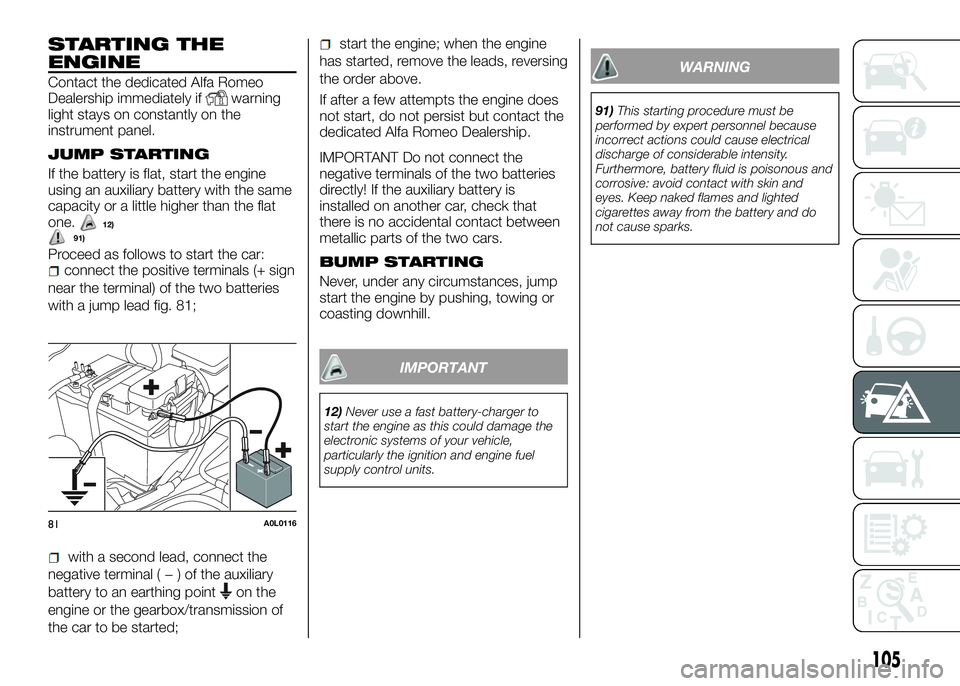
STARTING THE
ENGINE
Contact the dedicated Alfa Romeo
Dealership immediately ifwarning
light stays on constantly on the
instrument panel.
JUMP STARTING
If the battery is flat, start the engine
using an auxiliary battery with the same
capacity or a little higher than the flat
one.
Proceed as follows to start the car:connect the positive terminals (+ sign
near the terminal) of the two batteries
with a jump lead fig. 81;
with a second lead, connect the
negative terminal(−)oftheauxiliary
battery to an earthing point
on the
engine or the gearbox/transmission of
the car to be started;
start the engine; when the engine
has started, remove the leads, reversing
the order above.
If after a few attempts the engine does
not start, do not persist but contact the
dedicated Alfa Romeo Dealership.
IMPORTANT Do not connect the
negative terminals of the two batteries
directly! If the auxiliary battery is
installed on another car, check that
there is no accidental contact between
metallic parts of the two cars.
BUMP STARTING
Never, under any circumstances, jump
start the engine by pushing, towing or
coasting downhill.
IMPORTANT
12)Never use a fast battery-charger to
start the engine as this could damage the
electronic systems of your vehicle,
particularly the ignition and engine fuel
supply control units.
WARNING
91)This starting procedure must be
performed by expert personnel because
incorrect actions could cause electrical
discharge of considerable intensity.
Furthermore, battery fluid is poisonous and
corrosive: avoid contact with skin and
eyes. Keep naked flames and lighted
cigarettes away from the battery and do
not cause sparks.
81A0L0116
105
91)12)
Page 125 of 182
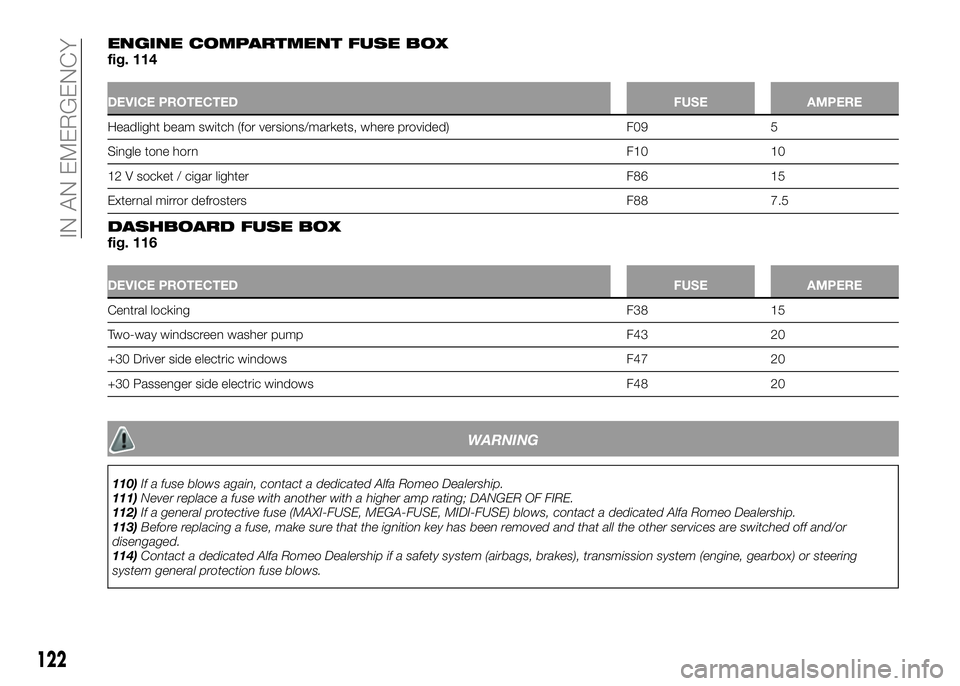
ENGINE COMPARTMENT FUSE BOXfig. 114
DEVICE PROTECTEDFUSE AMPERE
Headlight beam switch (for versions/markets, where provided) F09 5
Single tone hornF10 10
12 V socket / cigar lighter F86 15
External mirror defrosters F88 7.5
DASHBOARD FUSE BOXfig. 116
DEVICE PROTECTEDFUSE AMPERE
Central lockingF38 15
Two-way windscreen washer pump F43 20
+30 Driver side electric windows F47 20
+30 Passenger side electric windows F48 20
WARNING
110)If a fuse blows again, contact a dedicated Alfa Romeo Dealership.
111)Never replace a fuse with another with a higher amp rating; DANGER OF FIRE.
112)If a general protective fuse (MAXI-FUSE, MEGA-FUSE, MIDI-FUSE) blows, contact a dedicated Alfa Romeo Dealership.
113)Before replacing a fuse, make sure that the ignition key has been removed and that all the other services are switched off and/or
disengaged.
114)Contact a dedicated Alfa Romeo Dealership if a safety system (airbags, brakes), transmission system (engine, gearbox) or steering
system general protection fuse blows.
122
IN AN EMERGENCY